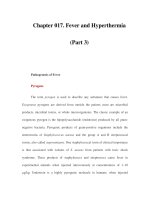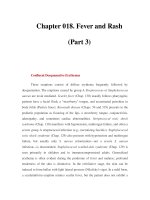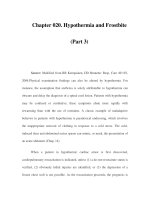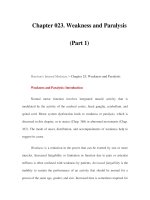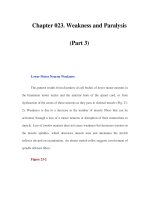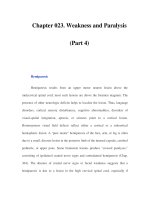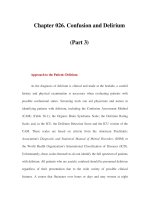Chapter 034. Cough and Hemoptysis (Part 3) pps
Bạn đang xem bản rút gọn của tài liệu. Xem và tải ngay bản đầy đủ của tài liệu tại đây (13.49 KB, 5 trang )
Chapter 034. Cough and
Hemoptysis
(Part 3)
Complications
Common complications of coughing include chest and abdominal wall
soreness, urinary incontinence, and exhaustion. On occasion, paroxysms of
coughing may precipitate syncope (cough syncope; Chap. 21), consequent to
markedly positive intrathoracic and alveolar pressures, diminished venous return,
and decreased cardiac output. Although cough fractures of the ribs may occur in
otherwise normal patients, their occurrence should at least raise the possibility of
pathologic fractures, which are seen with multiple myeloma, osteoporosis, and
osteolytic metastases.
Cough: Treatment
Definitive treatment of cough depends on determining the underlying cause
and then initiating specific therapy. Elimination of an exogenous inciting agent
(cigarette smoke, ACE inhibitors) or an endogenous trigger (postnasal drip,
gastroesophageal reflux) is usually effective when such a precipitant can be
identified. Other important management considerations are treatment of specific
respiratory tract infections, bronchodilators for potentially reversible airflow
obstruction, inhaled glucocorticoids for eosinophilic bronchitis, chest
physiotherapy and other methods to enhance clearance of secretions in patients
with bronchiectasis, and treatment of endobronchial tumors or interstitial lung
disease when such therapy is available and appropriate. In patients with chronic,
unexplained cough, an empirical approach to treatment is often used for both
diagnostic and therapeutic purposes, starting with an antihistamine-decongestant
combination, nasal glucocorticoids, or nasal ipratropium spray to treat
unrecognized postnasal drip. If ineffective, this may be followed sequentially by
empirical treatment for asthma, nonasthmatic eosinophilic bronchitis, and
gastroesophageal reflux.
Symptomatic or nonspecific therapy of cough should be considered when:
(1) the cause of the cough is not known or specific treatment is not possible, and
(2) the cough performs no useful function or causes marked discomfort or sleep
disturbance. An irritative, nonproductive cough may be suppressed by an
antitussive agent, which increases the latency or threshold of the cough center.
Such agents include codeine (15 mg qid) or nonnarcotics such as
dextromethorphan (15 mg qid). These drugs provide symptomatic relief by
interrupting prolonged, self-perpetuating paroxysms. However, a cough
productive of significant quantities of sputum should usually not be suppressed,
since retention of sputum in the tracheobronchial tree may interfere with the
distribution of alveolar ventilation and the ability of the lung to resist infection.
HEMOPTYSIS
Hemoptysis is defined as the expectoration of blood from the respiratory
tract, a spectrum that varies from blood-streaking of sputum to coughing up large
amounts of pure blood. Massive hemoptysis is variably defined as the
expectoration of >100–600 mL over a 24-h period, although the patient's
estimation of the amount of blood is notoriously unreliable. Expectoration of even
relatively small amounts of blood is a frightening symptom and may be a marker
for potentially serious disease, such as bronchogenic carcinoma. Massive
hemoptysis, on the other hand, can represent an acutely life-threatening problem.
Blood can fill the airways and the alveolar spaces, not only seriously disturbing
gas exchange but potentially causing asphyxiation.
Etiology
Because blood originating from the nasopharynx or the gastrointestinal
tract can mimic blood coming from the lower respiratory tract, it is important to
determine initially that the blood is not coming from one of these alternative sites.
Clues that the blood is originating from the gastrointestinal tract include a dark red
appearance and an acidic pH, in contrast to the typical bright red appearance and
alkaline pH of true hemoptysis.
An etiologic classification of hemoptysis can be based on the site of origin
within the lungs (Table 34-1). The most common site of bleeding is the
tracheobronchial tree, which can be affected by inflammation (acute or chronic
bronchitis, bronchiectasis) or by neoplasm (bronchogenic carcinoma,
endobronchial metastatic carcinoma, or bronchial carcinoid tumor). The bronchial
arteries, which originate either from the aorta or from intercostal arteries and are
therefore part of the high-pressure systemic circulation, are the source of bleeding
in bronchitis or bronchiectasis or with endobronchial tumors. Blood originating
from the pulmonary parenchyma can be either from a localized source, such as an
infection (pneumonia, lung abscess, tuberculosis), or from a process diffusely
affecting the parenchyma (as with a coagulopathy or with an autoimmune process
such as Goodpasture's syndrome). Disorders primarily affecting the pulmonary
vasculature include pulmonary embolic disease and those conditions associated
with elevated pulmonary venous and capillary pressures, such as mitral stenosis or
left ventricular failure.
